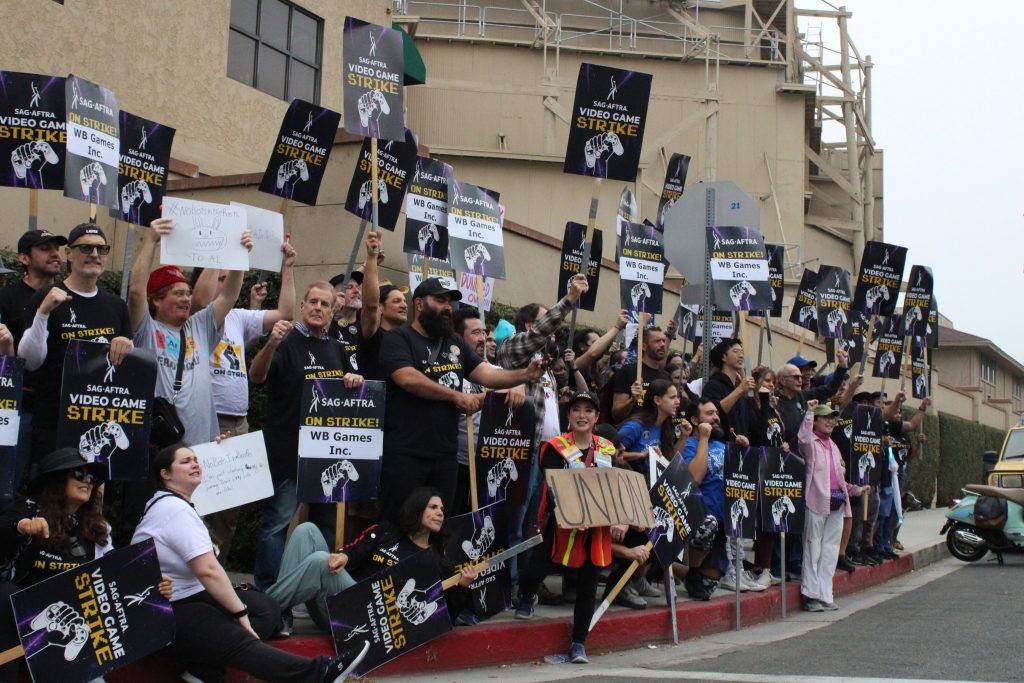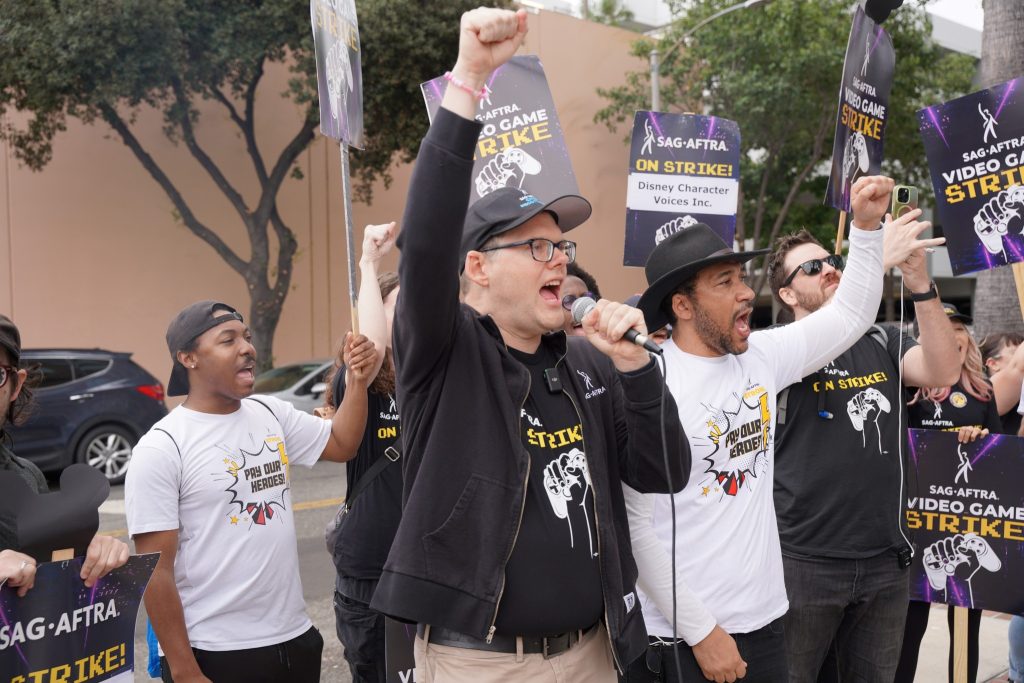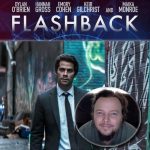LA Comic Con 2024 interview: Movement Performers and the Video Game Strike

One of the many panels at this year’s Los Angeles Comic Con was “Behind the Masks: Movement Performers Role in the Video Game Strike”. It consisted of four video game performers to talk about the SAG-AFTRA strike, the use of AI in the gaming industry, and what it means to be a movement performer.
While I didn’t attend the panel itself (it was up against the What We Do in the Shadows panel, and when I told the team this, they all said variations of ‘Totally understand’ and ‘I’d do the same’), I did manage to sit in on a group interview after hosted by Keeping Up with the Nerds.
Consisting of Sarah Elmaleh, Seth Allyn Austin, Andi Norris, and Jasiri Booker, the four talked about the problems they currently face in their jobs, the biggest being that they typically have no idea of what the character is going to be before going in to record.
When asked who has creative control over the creation of the character – whether it’s the voice actor, the performer, the writer, or a combination, Austin simply said “Yes”. In other words, it’s a bit of everyone. However, Booker added that if you had to pick one person, it’d be the creative director.
“I think it’s also a situation of the best it usually wins,” Austin continues. “Studios hire the actor, hire the movement professional, hire all these people so that they can bring their expertise. If you weren’t looking for an individual who could bring either a part of themselves or their experience to every character they bring, then you could bring anyone from off the street. That’s kind of what we’re looking at with the whole AI thing: all of a sudden, there’s this tool that’s so powerful that you’re giving one person the power to determine how everything looks.” He went on to explain that it’s that collaboration that makes the character creative.
Of course, the secrecy of the gaming industry is partly why the performers aren’t told much before they’re brought in. “They really only have that launch day to make their money back is the thinking,” said Norris. “So if anything gets leaked ahead of time, then that drastically impacts their sales.”
As with any creative project, it also depends on the project. “Sometimes we get something,” Norris continued. “Especially if I’m coming in to play a creature, I often have a general idea or I might have a Zoom a couple days ahead of time with the creative director, and they’ll walk through what this creature needs to do so that I can be prepared. But that’s not across the board standard.”
As for getting the specifics of the character in advance, Elmaleh talked about other factors as to why that may happen. “I think part of it is the secrecy that you mentioned,” she said, gesturing to Norris. “Sometimes, it’s preparation, to be honest. As a voice director, it’s just how many scripts are coming in down to the wire. Sometimes it’s not that we didn’t get it because they didn’t want to share it, it’s they’re writing it up until the session moment. There can be a surprising lack of planning for sessions, and I’m sure that’s true for movement, too. And some of it might just be that they are excited to see what you fill in in the blanks, and they just embrace the collaborative process, which is ideal.”
Elmaleh is not only a voice actor but a director as well, so has thoughts on it from the other side of the process. “For me as a director especially, you start with these parameters, you start with the generalities, and you start to place them, and be as specific as you can,” she said. “For me, what’s really joyful and special about this work is the moment where a strange instinct takes over. I’m speaking as a director now: when I see an actor find a strange detail that adds a whole other dimension to the character, [it] adds a whole other layer. When you start to place those specificities that don’t contradict what you’ve already set up but really expand it, then your character starts to feel real and you can see your actors start to own the character and feel like it’s really particular to them. And when they have that ownership, suddenly their energy for play and their creative freedom and their lack of inhibition, that just opens up worlds and possibilities, and the rest of the character comes from that.”
Cost is also a big issue as to what goes on in the process. Elmaleh talked about how part of her job is to reassure the ones looking at those costs. “As a director, I have to reassure teams,” she said. “[These] teams who are nervous, they’re spending money on the session. They’ve got this character in their head; maybe they know how to communicate it, maybe they don’t, maybe they’re relying on me to communicate that. This is what these first 20 minutes are for. It’s to try stuff, to fail, to feel comfortable failing. My job is to set that space so that actors know that they’re safe to try things and for things to not be perfect every time. There is no perfect. And so safeguarding that collaborative process, especially in that early character-finding phase, is so important, and a lot of that is trust and belief in a collaborative process.”

The conversation then turned to the SAG-AFTRA strike. Like it or not, video games are still down the list for many people when considering something as art and entertainment. As such, it tends to be last (if thought of at all) when it comes to recognition and acknowledgement.
Elmaleh, currently serving as the chair of SAG-AFTRA’s Interactive Media Agreement negotiating committee, had thoughts on that as well. “As someone who grew up playing games, too, I’ve always been ‘Why don’t we talk about these things in the same sentence? Why don’t we talk about film and books and all these things together? They’re all these art forms. We consume them. We as players, obviously, tend to like lots of all these different kinds of things,'” she said.
“Technically speaking, we did start negotiating this contract well before TV theatrical,” Elmaleh continued. “So just as a timeline thing, we started negotiating this contract in 2022. I started looking into AI as an issue many months before that. And so we were negotiating before they started negotiating while they were on strike, once they finished striking, we’ve been negotiating this full-time.
“So, I would redirect that answer back to the question of why are these game companies not seeing themselves as part of the same industry? There’s been a historic resistance to saying, ‘We’re part of the entertainment industry.’ No, they’re like, ‘No, we’re tech.’ Well, but you’re coming to hire entertainers, you know? And there’s this big thing of games being fun, that’s entertaining. You’re entertaining people. I think you might be entertaining people.”
The strike itself was next. The panel (mostly Elmaleh) talked about the list of issues as to why the performers are on strike, from not only AI but wages, work safety conditions (for example, there is not a requirement to have a set medic on set for hazardous days of shooting), to getting an appropriate amount of rest breaks (and time in said rest breaks).
“A lot of these things: it’s expected that the performer know how to advocate for themselves,” Austin said. “A lot of us have been doing this for a long time, and we know our tool, we know our instrument, and we’re comfortable enough in our career where we can say, ‘Hey, I’m tired, I’m gonna take a break.’ But someone who is on their first day and doesn’t know how to speak up for themselves – that’s not written in there, so they don’t know how to ask for it. That person deserves the same agency to ask for a break.”
At the time of the interview, they had come to a tentative agreement on wages and safety, but still had AI as an issue to resolve, specifically generative AI that is used specifically to make more performances based on work they would normally be hired to do. “I think [there should be] transparency around what the use that you want to use it for, getting our permission, making sure that it’s required to get our consent for that, and then paying us fairly,” said Elmaleh. “So far, it’s kind of the institutional position. It’s very reasonable. It’s not preventing the use of this tool. It’s saying, ‘Hey, we just want to keep collaborating. This tool is part of what you’re going to use. It’s deeply connected. It’s intimately from my work. I need to be part of that collaboration process and part of that collaboration conversation.’
“That hashing out the details: who’s covered? What does it mean to replicate somebody? All of these things we’ve worded very carefully in order to make sure that it accurately reflects the kind of agency that we have right now when we’re talking about advocating for yourself. You can set a boundary on set with the way we do our work now, and say, ‘I’m not going to give that to you, because I’m actually that’s going to injure me. I don’t feel comfortable with that because of my background, maybe my sexual orientation or my identity.’ I can withhold my work and kind of make that collaboration a bit of a negotiation, right?
“And that’s just built into how we work right now. [That’s] true for movement just as it is for voice. So all we’re saying is we need to have that conversation even when I’m not there. If you’re going to be able to do it without me there, I need to make sure it’s in my contract so that you still come back and talk to me and I have the same degree of control. I deserve to have control of that piece if it’s something that could be really violating to me.”
The Keeping Up with the Nerds interview also goes into their reasons for getting into the industry, as well as their thoughts for people who might be interested in becoming a movement performer.

I managed to ask a couple of questions myself. Diversity in gaming is a big hot-button issue at the moment, so I asked their thoughts.
“I think one of the things that really strikes me around fighting over AI provisions specifically in our in our contract package,” said Elmaleh, “is the impact on diversity and authentic representation in games. So, when you’re talking about generative AI systems, they are kind of regurgitating what they can find. And what’s out there right now is still just a backlog of really stereotyped portrayals of all kinds of people. So far, the progress that has been made in terms of diversity in games or in any media is through collaboration. It’s through an intentional effort to find folks who can bring some degree of lived experience to that collaboration, to work together, to remove what you might expect or what you’ve been trained to expect based on past stereotypes. And that requires human collaboration. So, any tool that’s just going to kind of go off of what’s been there before is going to move backwards in the opposite direction. So that’s one under-discussed piece of talking about the use of AI in games and around these controls specifically.”
“I think it’s an interesting conversation,” said Booker. “I think it’s hard because it is such a niche part of the entertainment industry. It’s like, ‘we need to find somebody who checks all these boxes’, and sometimes it’s very hard to find that person with a level of skill that you’re looking for. So I think a lot of it is just being able to give that demographic enough respect or attention to the lived experience, because I think what it is is people get upset when they don’t feel like they are represented accurately. But I feel like there are ways that you can represent certain communities without necessarily being a part of them. As long as you are going to them for advice, you are making sure that you are getting informed on your performance. There are some performers who really care about getting that, and there are others who don’t. So I think it’s just finding the people who, even if they don’t necessarily fit into that demographic, they are paying respect and homage to that demographic in a way that shows intention and care.”
“It’s an interesting thing,” Austin added. “As a performer, [as mentioned], a lot of the time, you don’t know what you’re going to do until you walk into that volume. Every once in a while, it can feel like a trap when you walk in and you’re going to – as a white man, all of a sudden, you’re asked to play an entire group from Africa. Which I have done. I have no problem not doing that job. But when you’re there and they say, ‘Do it,’ you’re put in an uncomfortable situation. It’s a compromising situation.”
“I think there’s always a performer for it that fits that,” said Norris. “But I do understand that sometimes that performer can be very hard to find, and you may have one performer who hits all these boxes. One of the things I get hired for because of my size is to play kids. And that’s even harder, right? When you need a kid from a very specific diverse background, but you need the performer to actually be this size in relation to the other performers on set. And so I do a lot of research, because I don’t want to misrepresent somebody, and I think that what we really need to do is actually train more performers.”
I also asked what they hoped people got out of the panel. Austin said he hoped that the presentation “shed light on the artists that are movement performers. There are tons of characters that you can empathize with that don’t say a single word. So I think that the panel was just showing that movement is also performance.”
Elmaleh said she hoped that the big takeaway was that there was more work put into games than maybe you thought. “The creativity involved, the fact that we do multiple characters involved, the fact that we’re really spontaneous, that all of that creativity and skill and talent is just is there, and often quite similar in process to our incredibly talented movement performers,” she said. “If you haven’t been thinking about who the human being behind, what makes your characters look and feel really cool to play or feel really specific or feel really embodied to play, that you can start expanding your awareness and your appreciation to this category of performers.”
On October 28, SAG-AFTRA and Ethovox announced a new agreement that ensures performers are protected and empowered in the A.I. age. “In addition to ensuring performers can participate in Ethovox’s consensual foundational model knowing that they will be protected and compensated fairly, the voice model will reflect a commitment to diversity and inclusion,” stated the press release. “Further, the SAG-AFTRA-Ethovox contract leads the field in performer compensation as it provides both session fees and ongoing revenue sharing for the life of the foundational model.”
You can learn more about the agreement here.
Author: Angie Fiedler Sutton
Angie Fiedler Sutton is a writer, podcaster, and all-round fangirl geek. She has been published in Den of Geek, Stage Directions, LA Weekly, The Mary Sue, and others.
She also produces her own podcast, Contents May Vary, where she interviews geeky people about geeky things. You can see all her work (and social media channels) at angiefsutton.com.
Help support independent journalism. Subscribe to our Patreon.
Copyright © The Geekiary
Do not copy our content in whole to other websites. If you are reading this anywhere besides TheGeekiary.com, it has been stolen.Read our






